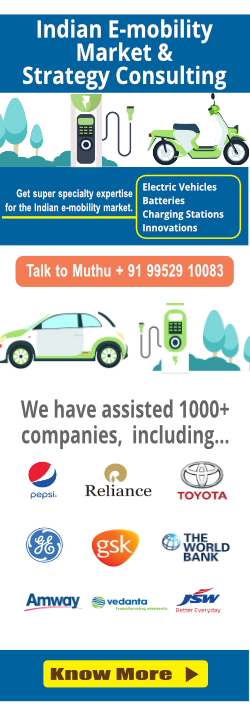A recent news item from Bloomberg mentioned that financial analysts were rating Tesla higher for something beyond cars: Its solar power generation and energy storage (battery) business.
Mainly because they all feel that solar + storage could provide the company as much as its electric cars do.
You might wonder what solar has got to do with electric vehicles? And why should Tesla having a finger in solar and storage should matter at all to investors.
This post reviews the intersections of EVs, solar and storage. Inputs from this post could provide more clarity on this intersection and why it matters.
Battery storage for renewable energy
For the past several decades, batteries have been used for energy storage in stationary applications, mainly as a backup power source or for regulating and stabilizing grid power supply. The battery energy storage systems perform the role of enhancing frequency or voltage regulation, as well as enhance the power quality during grid shutdown.
Recent developments have shown an increase in the usage of battery-based energy storage systems in larger distributed renewable energy sources such as solar power systems. In addition to performing the roles mentioned earlier for conventional stationary applications, energy storage goals for renewable energy sources include the following additional aspects:
- Peak shaving/shifting – Batteries can release the stored energy to the grid during peak power demand periods, thus enabling conventional power plants to reduce their expensive peak power production.
- Renewables firming for grid integration – Where batteries are proposed to be used for large, ground-mounted solar power systems, the main objective is to ensure a more consistent power export to the grid than what would be otherwise possible for an infirm source.
Since 2017, there has been a significant increase in the usage of batteries for traction applications, especially electric vehicles. With the expected fast pace of electric vehicle growth globally and in India, one can also expect a parallel increase in the use of batteries in this sector.
Battery use trends in solar power plants
Use of lead acid batteries in solar power plants
Within renewable energy, currently solar power plants are the most dominant users of batteries.
For many years now, lead acid batteries have been used in Uninterruptible Power Supply (UPS) and in conventional vehicles.
In addition, lead acid batteries have also been used in conventional power plants for load levelling for almost three decades. Such battery storage power plants are used for short-term peak power and ancillary services, such as providing a frequency-response reserve to minimize the chance of power outages. One of the oldest such lead-acid battery storage installations is a 10 MW/40 MWh unit named the Chino Battery Storage Project that was operated between 1988 and 1997 by the Southern California Edison in the Californian city Chino. This project was mainly for grid stabilization during frequent power outages in the region.[1] Such large installations of lead acid batteries as part of conventional power generation are however quite rare.
Lead acid batteries have been far more frequently used in solar power plants. A large number of small off-grid solar power plants worldwide already use lead acid batteries, and they also find a place in many rooftop solar power plants. Use of batteries in large-scale ground-mounted solar power plants has been more recent, and both lead acid and Li-ion batteries have been used in these large-scale solar power projects.
In India, almost all solar power plants (off-grid and rooftop solar power plants) have relied on lead acid batteries until 2019.[2]
Use of Li-ion batteries in solar power plants
Globally, the use of Li-ion batteries for solar power projects started around 2015, which was the period when Li-ion battery prices went below the $500/kWh barrier for the first time. Since then, use of Li-ion batteries has been on the ascendancy in solar power projects.
Its use in rooftop solar power systems got a significant boost with Tesla’s use of these batteries in Powerwall and Powerpack in 2015. Since then, some of the earliest storage systems for ground-mounted solar power plants in the developed economies have started using Li-ion batteries, with Tesla’s Dec 2017 commissioning of a 100 MW/129 MWh Li-ion battery storage in Hornsdale, South Australia being one of the most prominent so far.[3],[4],[5]
Li-ion battery’s use for solar power plants in developing and under-developed economies is however very low as of 2019, owing primarily to its high cost.[6]
[1] https://arc.aiaa.org/doi/abs/10.2514/6.1987-9435
[2] Based on EAI’s knowledge of the solar power sector in India and also based on inputs from stakeholders interacted with during the study
[3] https://www.irena.org/-/media/Files/IRENA/Agency/Publication/2019/Sep/IRENA_Utility-scale-batteries_2019.pdf?la=en&hash=8187F00E87173BC653DEDA566C7A4A88EAD9514A
[4] https://www.energycentral.com/c/cp/large-battery-energy-storage-systems
[5] https://www.gihub.org/resources/showcase-projects/hornsdale-power-reserve-project-australia/
[6] Inference based on EAI’s extensive consulting and research work in the solar power sector, which included reviews of solar power plant installations worldwide
Battery use trends in e-mobility
All electric vehicles need energy storage. Currently, a very large proportion of this energy storage is through the use of batteries. While fuel cells present the other technologically viable option, fuel cell use is far less prevalent in electric vehicles today compared to that of batteries.
So, for all practical purposes, batteries are practically the only energy storage technology for today’s electric vehicles. That said, there’s a wide range and types of batteries used in electric vehicles.
Depending on the type of electric vehicle, the capacity of the battery will differ. A small electric bicycle or a low-end electric scooter could use a 12 V, 250 Wh battery, while a large electric bus could be using a battery with energy capacity of 200 kWh and over 400 Volts, almost 800 times the capacity of the battery used in an electric bicycle.
The types of batteries used differ from one type of vehicle to another. Given the low energy densities of lead acid batteries (30-50 Wh/kg) compared to those of Li-ion batteries (up to 200 Wh/kg), larger electric vehicles (cars, buses, trucks) almost always use Li-ion batteries, while electric two-wheelers and three-wheelers can consider either Li-ion or lead acid. Owing to their higher energy density, Li-ion batteries can typically provide a longer range for the electric vehicle per charge.
Where lead acid batteries score over Li-ion batteries is in cost – as of 2019, lead acid batteries cost less than half that of Li-ion batteries for the same energy capacity.
Thus, there are pros and cons to the use of both lead acid and Lithium-ion batteries in electric vehicles – while the former has a lower upfront cost, the latter can provide a longer range per charge and also has a longer lifetime than the former. However, Li-ion batteries are increasingly becoming the battery of choice for most types of electric vehicles and for most geographies.
Types of batteries used in different solar power installations in different regions[1]
| Type of economy | Type of solar power installation | |||
| Off-grid | Rooftop-residential | Rooftop-commercial & industrial | Ground-mounted solar power projects | |
| Developed economies | 100% with batteries, both Lead Acid and Li-ion | Solar power projects only in select regions include batteries, rest are grid interactive | Use of batteries mainly to use solar power during peak periods to offset high electricity rates | Use of batteries in MW-scale solar power projects has seen a significant increase in the past two years |
| Developing economies | 100% with batteries, mainly lead acid | Batteries used only in those regions with significant grid outages | Very few installations use batteries | Battery storage for ground mounted solar power projects are quite rare in the developing countries, with countries such as India only recently starting to explore this seriously. However, within this segment, many island nations with a significant reliance on diesel for power had started installing solar plus storage power projects since 2017. |
| Underdeveloped economies | 100% with batteries, only lead acid | Many residential solar power installations use batteries owing to frequent grid outage | Very few installations use batteries | There’s almost no large battery incorporated ground-mounted solar power project in underdeveloped nations as of mid-2019 |
[1] Based on EAI research and analyses
Conclusion
Thus, once we consider all these, it becomes apparent that there is a significant fit between EVs and batteries (and solar too perhaps, in future). Tesla having a significant finger in each of these three critical pies does augur well for its future.



 Retaining Great Talent in Fast-Growing Startups: Illumine Industries’ Approach
Retaining Great Talent in Fast-Growing Startups: Illumine Industries’ Approach




